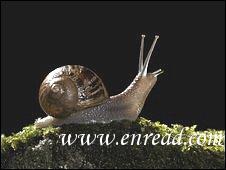| ||||||||||||||||||||||||||||||||||||||||||||||||||||||||||||||||||||||||
|
Garden snails2 are evolving slower metabolisms4. 花园蜗牛新陈代谢进化缓慢。 Helix aspersa, a snail1 with a hidden advantage Natural selection is favouring snails with reduced metabolic5(新陈代谢) rates, researchers in Chile have discovered. It is the first time that evolution has been shown to select for this trait(特征,特点) in individuals of any species. Snails with lower metabolisms are at an advantage because they have more energy to spend on other activities such as growth or reproduction, the researchers say in the journal Evolution. Roberto Nespolo and Paulina Artacho of the Southern University of Chile in Valdivia examined a long standing6 biological hypothesis known as the "energetic definition of fitness". "This predicts that animals that spend less energy will have more surplus(多余的,过剩的) for survival and reproduction," says Nespolo. Few studies have tested the idea, and three done on rodents(啮齿类)could not find any evidence it was true. "Ours is the fourth and the first to demonstrate significant directional selection(定向淘汰) on metabolism3," says Nespolo. Nespolo and Artacho measured the size of almost 100 garden snails (Helix aspersa). They also gauged7(校准的,标准的) their standard metabolic rate (SMR), by measuring how much carbon dioxide each animal produced while at rest. The standard metabolic rate is a measure of the minimal8 amount of energy an animal requires to stay alive. "Standard metabolic rate is the energy required for maintenance(维护,保持). In other words, having less maintenance permits you to have more energy for other activities, such as growth and reproduction. That's why less metabolism represents higher fitness," says Nespolo. After seven months, they recaptured the animals, collecting the empty shells of those which had died. Survival of the SMR They found size did not predict which animals survived. But metabolic rate did, with surviving snails having a metabolic rate 20% lower than that of the snails that didn't survive. And the lower each snail's metabolic rate, the greater its chance of survival. That means that nature is selecting for snails that are more energy efficient, says Nespolo. Nespolo's and Artacho's study worked in part because of the snails they chose to study. Previous research examined metabolism in wild mice. But it's impossible to know whether mice that disappear from a study have died, or simply moved away. So it's difficult to accurately9 measure how many mice survive year to year. By studying garden snails living in purpose-built enclosures, Nespolo and Artacho avoided this problem, as their snails did not move far and left behind empty shells when they died. "We could recover the dead because of their shells and because they did not move more than a couple of metres each year," says Nespolo. Snail's pace The researchers now plan to answer the ultimate question: is having a slow metabolism linked to moving slowly? If it is, that means that snails are not only evolving to use energy more slowly, but are increasingly moving at an even lower snail's pace. 点击  收听单词发音 收听单词发音
|
||||||||||||||||||||||||||||||||||||||||||||||||||||||||||||||||||||||||
- 发表评论
-
- 最新评论 进入详细评论页>>




